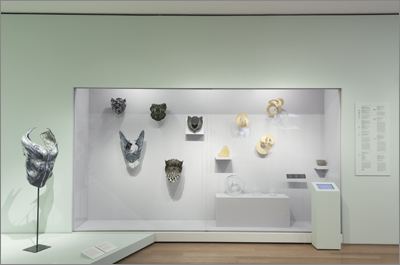Institute's human organ-on-a-chip design recognized for its elegance and potential societal impact
(BOSTON and NEW YORK) — Samples of the Wyss Institute’s Human Organs-on-Chips were formally acquired by The Museum of Modern Art (MoMA) of New York City on March 2, 2015, and are on display in MoMA’s latest Architecture and Design Exhibition, “This Is For Everyone: Design For The Common Good”, until January 2016. The human organs-on-chips were recognized by Paola Antonelli, the museum’s senior curator in the Department of Architecture and Design, for their state-of-the-art design and rendering which allows them to emulate complex human organ structures and functions using a combination of living cells and mechanical components encased in a flexible translucent polymer fabricated using computer microchip manufacturing methods.

The organs-on-chips devices are made of clear, silicone rubber and contain hollow channels that are lined by living cells and fed with flowing nutrient-rich fluids and liquid blood substitutes. The tissues mimic blood flow, air movements and physical distortion of internal organs, such as those caused by breathing motions and peristalsis, by application of cyclic vacuum through adjacent microchannels.
Scientists at the Wyss Institute led by the Institute’s Founding Director Donald Ingber, M.D., Ph.D., and former Wyss Technology Development Fellow Dan Dongeun Huh, Ph.D, first developed a living breathing lung-on-a-chip that was published in Science in 2010. The Wyss team also leveraged this design to create various kinds of organs-on-chips to represent different organs in the human body. They can be utilized on each’s own for the study of one specific organ, or their vascular, flowing channels can be connected to link different organs using a stream of fluid, mimicking the blood and nutrient movement through the human body’s vascular system. This feature allows scientists to replicate a human “body” on chips to see how drugs or chemicals impact each organ as the body metabolizes different compounds.
The design of organs-on-chips is highly effective at mimicking the function of real human organs because it contains cultures of living cells from different types of tissues, including blood capillaries, that make up living organs, and because the chips replicate the physical motions and flow seen in the human body that are crucial for organ function.
From the numerous different organs-on-chips created by Ingber and his team, the human lung-on-a-chip, gut-on-a-chip, and liver-on-a-chip have been selected for display at MoMA. Their installation in the exhibition “This Is For Everyone: Design Experiments for the Common Good” opened to the public on February 14, 2015 and will remain on display until January 2016.

The exhibition explores contemporary design in the digital age and takes its name from a 2012 tweet by Tim Berners-Lee, the British computer scientist who invented the World Wide Web in 1989. His message, This Is for Everyone, lit up the stadium at the Olympics Opening Ceremony during the 2012 games in London, and celebrated how the Internet has created limitless possibilities for information sharing and knowledge expansion.
“As design is absolutely key to everything we do at the Wyss Institute, and it has been a guiding light for me personally from the start of my career, it’s a thrill and an honor to see the organs-on-chips technology find a home amongst MoMA’s collection of world-renowned designs,” said Ingber, who is a founder of the emerging field of biologically inspired engineering. “I have always felt that great scientists are closer to artists than another other profession, and great advances come from crossing the boundary between these disciplines. So it’s exciting to see MoMA’s curators embrace the subtlety and simplicity of our microscale design, and communicate the power of bridging the art-science interface to the public.”
Human organs-on-chips represent a powerful alternative to animal testing models by mimicking human organs for purposes such as: testing of drugs, cosmetics, chemicals and toxins; understanding infections and inherited diseases; and creating replicas of personalized organs or organs of genetically-related subpopulations to advance precision medicine.
In 2014, the Boston-based startup company Emulate, Inc., launched out of the Wyss Institute to bring human organs-on-chips to commercialization.
